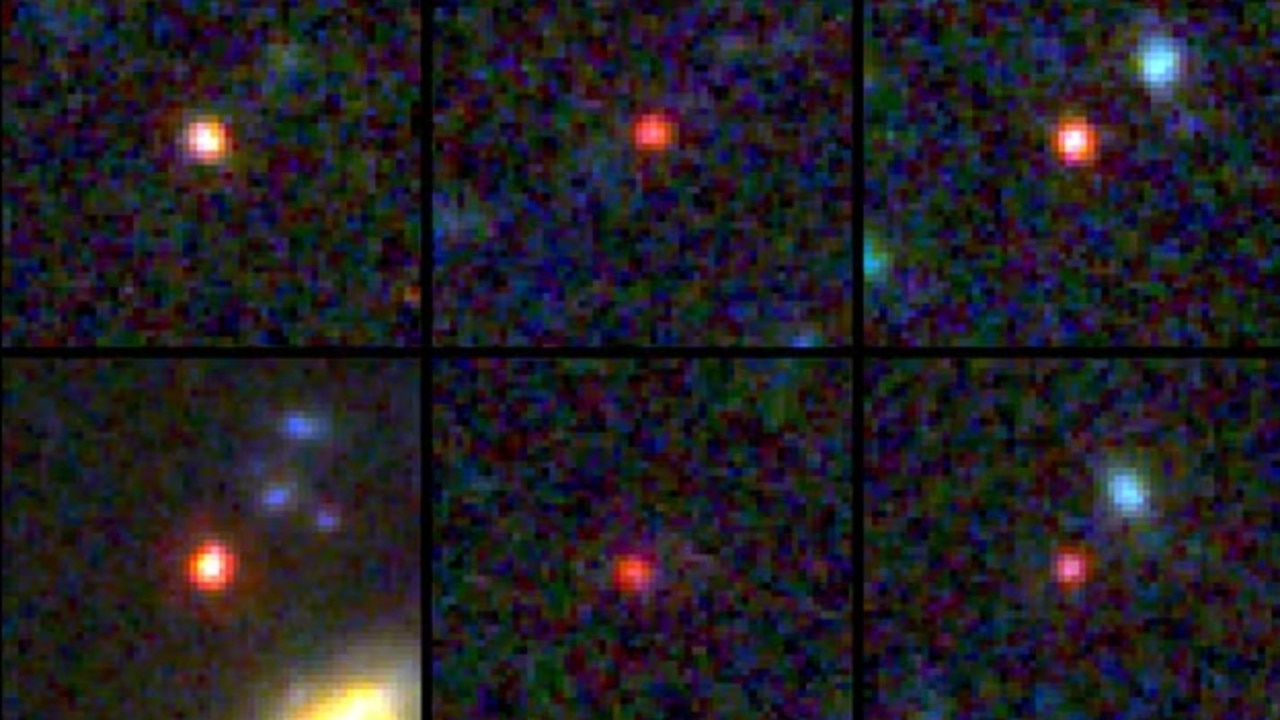Questions arise about the Big Bang after new galaxies spotted
NASA has spotted six enormous galaxies so ancient that researchers are now questioning the origins of the universe

READING LEVEL: ORANGE
NASA’s James Webb Space Telescope has spotted six enormous galaxies so ancient their existence could up-end* current theories of cosmology*.
The find has surprised many scientists. It’s thought galaxies* should not be anywhere near as big so soon after the beginnings of the universe, and could therefore contradict* scientists’ understanding of how it all began.
The stars examined in the new research are as much as 100 times greater than researchers had previously thought.
The telescope found galaxies* from between 500 to 700 years million years after the Big Bang* 13.8 billion years ago, meaning the universe was under five per cent of its current age.
The instrument observed the six galaxies in a little-known region of the sky.

These six new “candidate galaxies”, so-called because their discovery still needs to be confirmed by other measurements, contain many more stars than scientists expected.
One galaxy is even believed to have around 100 billion stars. That would make it around the size of the Milky Way, which is “crazy,” the study’s first author, Ivo Labbe said.
For this young galaxy to achieve the same growth in just 700 million years, it would have had to grow around 20 times faster than the Milky Way, said Mr Labbe, a researcher at Australia’s Swinburne University of Technology.
For there to be such massive galaxies so soon after the Big Bang goes against the current understanding of how the universe works.

“According to theory*, galaxies grow slowly from very small beginnings at early times,” Mr Labbe said, adding that such galaxies were expected to be between 10 to 100 times smaller.
But the size of these galaxies “really go off a cliff,” he said. What could be going on? One suspect is mysterious dark matter*, which makes up a lot of the Universe.
While much about dark matter remains unknown, scientists believe it plays a key role in the formation* of galaxies.
When dark matter comes together into a halo*, it attracts gas from the surrounding universe which in turn forms a galaxy and its stars, Mr Labbe said.
But this process is supposed to take a long time, and “in the early universe, there’s just not that many clumps of dark matter,” he said.
“The newly discovered galaxies could indicate that things sped up far faster in the early universe than previously thought,” said David Elbaz, an astrophysicist at the French Atomic Energy Commission, who not involved in the research.
This could be linked to recent signs that the universe itself is expanding faster than we once believed.
GLOSSARY
- cosmology: the science of the origin and development of the universe
- up-end: to turn something upside down
- contradict: the statement of a position opposite to what someone has already said
- galaxies: a system of millions or billions of stars
- Big Bang: scientists believe, the universe began in an event called the Big Bang. Under conditions of extreme heat, all the matter and energy that make up the universe spread out to create space
- theory: something suggested as a reasonable explanation for why things work or how things happen
- dark matter: the stuff in space that has gravity, but it is unlike anything scientists can identify
- formation: an arrangement of people or things
- halo: a band of light that appears around a source of light, such as the sun or moon
EXTRA READING
NASA can’t explain new smudges found on Saturn’s rings
NASA’s Artemis I bound for moon almost 50 years after last Apollo mission
Lift-off! NASA launches spaceship to the moon, beginning Artemis era of exploration
QUICK QUIZ
- What did NASA’s James Webb Space Telescope find?
- How much bigger are the stars identified by the telescope than previously thought?
- When did the Big Bang happen?
- What does “dark matter” play a role in forming?
- What does the astrophysicist at the French Atomic Energy Commission think the new findings means?
LISTEN TO THIS STORY
CLASSROOM ACTIVITIES
1. Find the evidence
Think of a new name for each of the six new galaxies. Each name must reflect, or say something, about the galaxies or about how important and groundbreaking their discovery has been. For each name, write sentences explaining your choice.
Time: allow 25 minutes to complete this activity
Curriculum Links: English, Science
2. Extension
How can the James Webb telescope be ‘looking back in time’? List all the information, or evidence, in the story that helps you to answer this question.
Time: allow 15 minutes to complete this activity
Curriculum Links: English, Science
VCOP ACTIVITY
Down-level it
When you up-level a sentence, you do things to it to improve it by making it more interesting or more complex.
But sometimes, when we read something it can be too complex and we don’t understand it very well. You ask someone to explain it to you, they do (in a simpler way) and you think, well why didn’t they just say that?
Go through the article and find a sentence or two that is complex, or hard to read.
Ask an adult what it means, or try and look some of the words up in the glossary.
Once you know what it means, see if you can rewrite it in a simpler way- down-level it.
Make sure you don’t change the meaning of the sentence in any way though.


